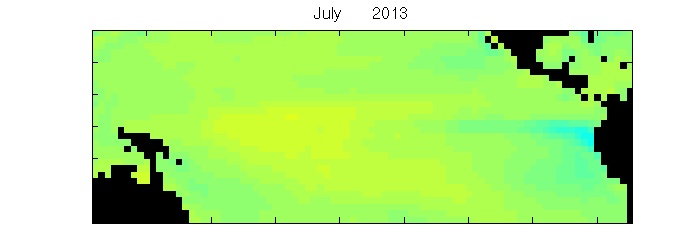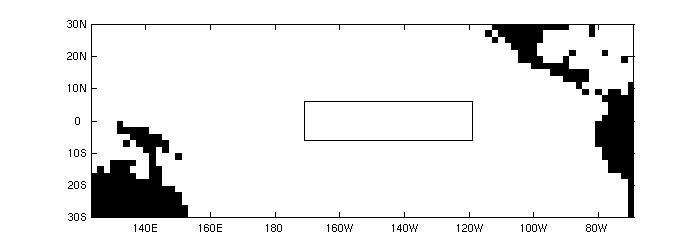This webpage was designed by Noel Cressie with the assistance of Mark Irwin. It presents research that began with a project between Cressie and Christopher Wikle while Wikle was a postdoctoral researcher in the Geophysical Statistics Project at the National Center for Atmospheric Research (NCAR). Subsequently, Cressie and Wikle were joined by Mark Berliner, and the research was funded by the U.S. EPA - Science to Achieve Results (STAR) Program Grant # R827257-01-0. (Disclaimer: Although the research described on this webpage has been funded in part by the U.S. Environmental Protection Agency's STAR program, it has not been subjected to any EPA review and therefore does not necessarily reflect the views of the Agency, and no official endorsement should be inferred.)
Berliner, Wikle, and Cressie (2000) presented a Bayesian dynamic forecasting model for prediction, with seven-month leads, of the tropical Pacific (29°S-29°N latitude and 124°E-70°W longitude) SST monthly anomalies. The model focuses on a statistical description of the temporal evolution of SST fields, though the Bayesian hierarchical dynamical approach taken is different from more classical statistical models of SSTs. Roughly speaking, one regresses future SST anomaly fields on past ones, as represented via empirical orthogonal functions. The regression coefficients are modeled as time-varying and follow a dynamic stochastic model. The Bayesian approach used seeks to (1) incorporate qualitative understanding of potential influences on SST evolution; (2) predict the regime status and regime shifts commonly associated with warmer-than-normal (i.e., "El Nino"-like), normal, and cooler-than-normal (i.e., "La Nina"-like) anomalies; and (3) provide both forecast information and quantification of uncertainty in the forecasts. We refer to the model as a Hierarchical Dynamic (HiDyn) Model. The authors would like to acknowledge the help of NCAR scientists (particularly Ralph Milliff and Dennis Shea) as the HiDyn Model was being developed.
The HiDyn Model uses current values of SST anomalies, the Southern Oscillation Index (SOI), and a summary of westerly surface-wind bursts as predictor variables. Rather than viewing the prediction as restricted to a single model, several statistical prediction models are developed. These models condition on the current regime state (Warm, Normal, or Cool), classified according to the current value of SOI, and then provide probabilistic forecasts of the future regime state (Warm, Normal, or Cool) seven months later. The probabilities of the future states are estimated based on the current SOI and the wind-burst statistic. The HiDyn Model yields predictive distributions that were computed by using a Markov Chain Monte Carlo (MCMC) program written by Christopher Wikle. The model was trained on monthly data beginning in 1970.
The HiDyn-Model output is the predictive distribution for SSTs in the Tropical Pacific Region, with a seven-month lead. Key summaries of this distribution include (i) probabilities of each of the three temperature regimes; (ii) SST mean-field estimates for each temperature regime; (iii) a combined mean-field estimate (the probability weighted average of the three fields in (ii)), and (iv) prediction intervals. One of the advantages of the HiDyn Model is that it allows us to focus easily on selected features of SSTs. Specifically, forecasts of the Nino 3.4 Region (see map below) can be easily obtained. In addition to "point forecasts" (e.g., means or medians) of Nino 3.4 (the average of SST anomalies over all pixels in the Nino 3.4 Region), the predictive distribution can be obtained and summarized. All these summaries are available on this webpage.
This research is featured in an article on The Ohio State University Research Communications webpage.
Reference:
L.M. Berliner, C.K. Wikle, and N. Cressie, 2000. Long-Lead Prediction of Pacific SSTs via Bayesian Dynamic Modeling. Journal of Climate, 13, 3953-3968.


